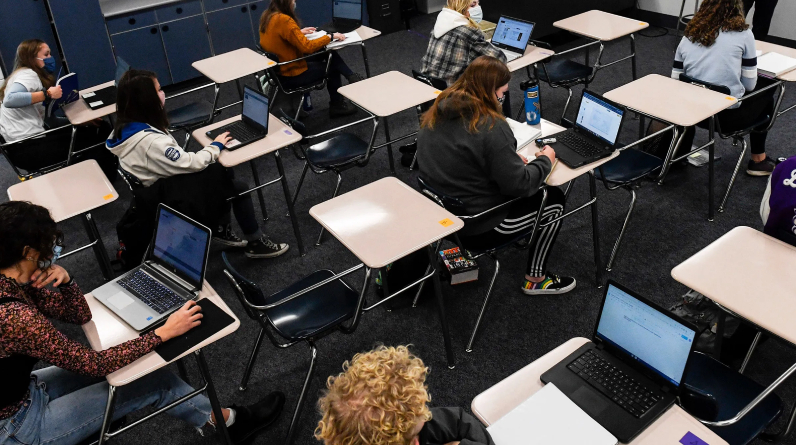AI has the potential to help create more equitable outcomes by facilitating the development of meaningful connections and learning experiences for children.
THE INSTANT that ChatGPT went viral, the age-old question of what new technologies can do for education was raised. Others praised its potential to inspire creativity and manage mundane educational tasks, while others worried it would worsen plagiarism and damage an already deteriorating humanism in the academy.
ChatGPT is, of course, just one of many AI advancements with the potential to change pedagogical practises. Governments and private foundations are pouring money into AI-powered tools that provide students with the right content, presented in the right way, at the right time to help them gain a deeper understanding of their coursework and perform better on exams.
Especially if they help reduce inequalities in things like reading proficiency by race, which the NAACP has called a “civil rights issue,” there’s good reason to be optimistic about these kinds of tools. However, a narrow view of education’s purposes lies beneath this enthusiasm. Learners are viewed as autonomous actors who may benefit from technological aid in expanding their horizons. The goal of education, then, is knowledge acquisition, which is evaluated by students’ grades and test scores.
But should we set our sights solely on becoming knowledgeable? Naming reading proficiency as a civil rights issue is likely less about the value of reading itself than about the foundation that reading (or math, or other subjects) mastery can help lay for what learning can unlock: breaking the intergenerational cycle of poverty, promoting greater self-awareness and self-confidence, and cultivating a stronger sense of agency over one’s own destiny and the destinies of one’s communities. Although mastery of subject matter is essential, making it the central focus of education ignores the fact that so many variables outside of school also influence a child’s development and eventual success. Networks, or the people to whom and how a family is connected, are crucial in preparing children for successful adulthood. This is especially the case for intergenerational and transnational networks. In fact, a recent large-scale study demonstrated that social capital, here understood to mean friendships across socioeconomic divides, can play a more significant role than educational attainment in promoting economic mobility across generations (often measured by the test scores of students who go there).
Forging new forms of support and trustworthy relationships between families and educators can be facilitated by networks that link parents to coaches to help them navigate their children’s schooling. The academic and professional futures of students can be altered by networks that introduce them to influential people who can serve as role models and mentors. In addition to academic achievement, a child’s broader social context is a major predictor of success in life. However, in practise, networks often form and evolve in inherently unequal ways if no action is taken to prevent this. For instance, “the rich get richer” may result from preferential attachment patterns that prevent many people from gaining access to relationships that could significantly improve their quality of life.

Every practical AI requires an objective function to characterise what it is trying to improve. Artificial intelligence (AI) in the classroom could be optimised to “help students get the highest possible score on a test.” However, unlike raising test scores, fostering more inclusive network connections is a fundamental and structural shift. To improve students’ long-term success, perhaps more than pedagogy and content mastery, we should use AI to help cultivate these networks.
Also Read : Five ways in which Web 3.0 will change online advertising
The formation and development of the networks in which children and families are embedded could provide a useful lens through which to examine this phenomenon. This refers to the various methods by which school districts choose which schools their students will attend (“school assignment policies”) and the methods by which parents choose those schools for their children. School segregation on the basis of race and socioeconomic status, which has been illegal in the United States for nearly seventy years, is still a defining characteristic of the system. Many academics contend that racial and ethnic integration programmes have been one of the most successful ways to improve the educational opportunities for marginalised groups and to promote greater empathy and tolerance, or even an ethic of pluralism, among diverse communities.
By aiding district-level planning efforts to redraw “school attendance zones”—i.e., catchment areas that determine which neighbourhoods feed to which schools—AI can assist in the design of more equitable school assignment policies that foster diverse and integrated schools without imposing large travel burdens or other inconveniences on families.
Alternative assignment policies that could optimise racial and socioeconomic integration in schools are being explored by existing researcher-practitioner partnerships and by myself and my collaborators Doug Beeferman, Christine Vega-Pourheydarian, Cassandra Overney, Pascal Van Hentenryck, Kumar Chandra, and Deb Roy using tools from the operations research community and rule-based AI like constraint programming.
These algorithms can streamline the process of identifying pathways to more integrated schools that balance a number of competing objectives by exploring a seemingly infinite number of boundary changes (like family travel times and school switching). To more accurately predict how new policies might affect school enrollment, they can be used in tandem with machine-learning systems, such as those that attempt to foresee parents’ decisions in the face of boundary shifts.
There are risks associated with every use of AI. Even if a school is integrated at the macro level, segregation may persist at the micro level, in classrooms and cafeterias, due to curricular tracking, a lack of culturally responsive teaching practises, and other factors. Applications also need to be framed within a suitable sociotechnical infrastructure that actively includes community members in the policymaking procedure. Nonetheless, using AI to help inform which students and families attend school with one another may trigger deeper structural changes that alter the networks students connect to, and thus the life outcomes they ultimately achieve.
However, changes in school assignment policies are not likely to result in long-term changes in the networks that students are plugged into if they are not accompanied by changes in school selection behaviours among families. Artificial intelligence may also help in this regard. For instance, thanks in large part to their incorporation into real estate sites like Redfin, digital school-rating platforms like GreatSchools.org are influencing how families evaluate and select schools for their children.
